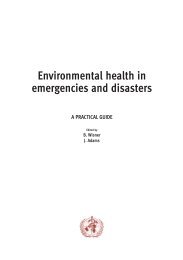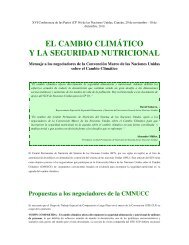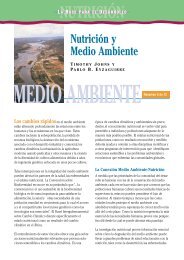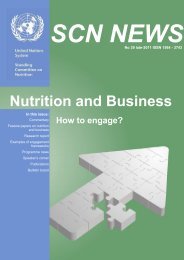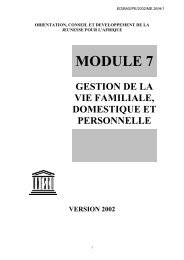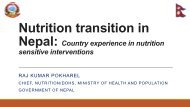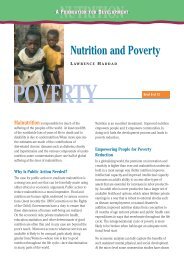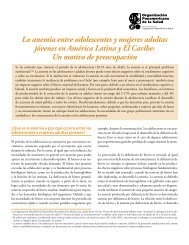SCN News No 36 - UNSCN
SCN News No 36 - UNSCN
SCN News No 36 - UNSCN
Create successful ePaper yourself
Turn your PDF publications into a flip-book with our unique Google optimized e-Paper software.
www.unsystem.org/scn FEATURES 47<br />
survey respondents was in fact the bickering among ourselves and our lack of consensus on priorities. That<br />
same finding was identified prominently by OPP respondents in the survey 10 years ago (Table 2).<br />
This time, infighting and the absence of consensus on priorities was cited (from among 13 options) as the<br />
main disappointment or negative factor by more than a quarter of the respondents, with this figure increasing<br />
to 44.4% among the 90 international agency respondents (three times higher than their second ranking disappointment).<br />
The finding supports the compelling plea for consensus made at the 33 rd <strong>SCN</strong> Annual Session<br />
by then-World Bank Senior Vice President Jean-Louis Sarbib, and his argument that the absence of consensus<br />
has reduced our credibility and, in turn, has constituted a primary constraint in our efforts to advance nutrition<br />
(Sarbib 2006). Some of this need for consensus was also highlighted in the new Lancet series (Morris<br />
et al 2008), and examples of infighting with serious consequences abound, e.g. one nutrition project blocked<br />
because it was to be run by the Department of Social Welfare rather than the Department of Health; another<br />
blocked because it might divert field staff from an agency’s family planning priority.<br />
When asked to identify the primary substantive limiting factor where malnutrition rates have not fallen significantly,<br />
i.e., comparing the three primary determinants of malnutrition in the UNICEF causality model, food<br />
insecurity was ranked highest (53.2%), followed by inadequate caring practices (28.4%), and then inadequacies<br />
in health services, hygiene and sanitation (18.4%.) (The percentage of OPP respondents – those on or<br />
closer to the front lines -- listing inadequate caring practices as a primary limiting factor (<strong>36</strong>.8%), was more<br />
than double that of RTT respondents (16.6%).) Clearly, however, the balance of attention here, as on several<br />
other issues raised in the survey, will have to be responsive to the specific primary limiting factors facing individual<br />
countries and regions.<br />
When asked to rank the population groups deserving primary attention in future nutrition interventions, “under<br />
twos” ranked highest, with 67.4% selecting this group as their first or second priority – suggesting that the<br />
compelling evidence on the importance of addressing the needs of this group is now getting through, especially<br />
among those dealing with operations. If the very young miss the boat during the first two years, they<br />
miss it for life, and are likely to suffer the consequences throughout their lives (Victoria et al 2008, World<br />
Bank 2006). Pregnant women ranked second with 49.1%.<br />
The “under five” age group, which not too many years ago was the reflex reaction answer to such a question and<br />
would then have been first, has diminished in importance, especially among those closer to the action. Worthy of<br />
note are the considerable differences between the OPP and RTT in responding to this under five group (35.0%<br />
versus 50.4%, respectively) and also in the school age group (10.1% versus 17.5%, respectively).<br />
When asked about the balance of attention that should be given to under versus over-nutrition in developing<br />
countries in the next 10 years, the overall tally indicated preference for a three-to- one balance (75% to 25%)<br />
in favour of undernutrition, with nearly two- thirds of program operations and policy respondents (65.1%) supporting<br />
that position.<br />
When asked if nutrition should maintain its own identity and institutionalization, as opposed to being encompassed<br />
by larger health sector or MCH programs, nearly four out of five respondents (79.2%) agreed, with<br />
more than half of these agreeing strongly. This level of agreement is substantially higher than the 54% who<br />
indicated that opinion to the same question in the survey 10 years ago. Whereas 20% disagreed strongly a<br />
decade ago, now only 2.4% do. It might be argued here that nutrition professionals are seeing increasing evidence<br />
of nutrition activity being marginalized when absorbed into broader health sector programs, and that<br />
they do not like what they see.<br />
Relatedly, when asked if the best means of addressing malnutrition problems in developing countries is<br />
through inputs which are solely nutrition/MCH-based, as opposed to multisectoral, 56.8% disagreed or disagreed<br />
strongly (32.4% agreed or agreed strongly with the rest remaining neutral). The nutrition community<br />
clearly would choose to have an independent identity in its programmatic activity, but would wish its efforts in<br />
such programs to be multisectoral.<br />
When respondents were asked specifically if they agreed that growth monitoring and promotion is not an effective<br />
means of facilitating nutrition improvement at the community level, 63.8% disagreed or disagreed<br />
back to contents <strong>SCN</strong> NEWS # <strong>36</strong>




